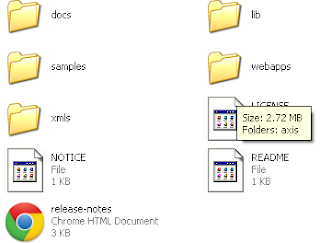Yesterday I tried to create webservice by using axis 1.1 in tomcat6. But I was not able to. I thought that the reason could be older version of AXIS 1.1. I read in web that though axis 2 is the current version, there are number of projects which are using AXIS1.1. Therefore I downloaded the latest version of axis 1.1 from apache axis 1.1 site. that version is axis-bin-1_4. When I unzipped it I got axis-1_4 folder. Inside the folder I had
Inside the webapps folder I had axis folder. I copied that axis folder to d:\tomcat6\webapps folder. I found that drop in deployment worked correctly. My jsf 2 application also working in the same tomcat6. I got correct result as what I got yesterday with tomcat5 and jsf1.1. AXIS 1.1 is not obsolete.
screen shot is given below
code is given below,
view.xhtml
--------------
<?xml version="1.0" encoding="UTF-8"?>
<!DOCTYPE html PUBLIC "-//W3C//DTD XHTML 1.0 Transitional//EN"
"http://www.w3.org/TR/xhtml1/DTD/xhtml1-transitional.dtd">
<html xmlns="http://www.w3.org/1999/xhtml"
xmlns:f="http://java.sun.com/jsf/core"
xmlns:h="http://java.sun.com/jsf/html">
<body bgcolor="cyan">
<h:form id="form1" >
<h:selectOneMenu id="operation" value="#{backer.state}">
<f:selectItem itemLabel="kerala" itemValue="kerala"/>
<f:selectItem itemLabel="tamilnad" itemValue="tamilnad"/>
<f:selectItem itemLabel="karnataka" itemValue="karnataka"/>
</h:selectOneMenu>
<h:commandButton id="button1"
action="#{backer.show}"
value="show" />
<h:inputTextarea rows="20" cols="40" id="text4" value="#{backer.result}" />
</h:form>
</body>
</html>
****************************************************
//backer.java
-------------
package mypack;
import javax.faces.bean.ManagedBean;
import javax.faces.bean.*;
import javax.faces.event.*;
import java.util.*;
@ManagedBean
@SessionScoped
public class backer implements java.io.Serializable
{
String result;
String state;
public void setState(String a) { state=a;}
public void setResult(String a) { result=a;}
public String getState() { return state; }
public String getResult() { return result; }
public String show()
{
tourjwshelper bean1 = new tourjwshelper();
String r=bean1.getcities(state);
setResult(r);
return null;
}
}
**************************************************
//tourjwshelper.java
package mypack;
import java.net.*;
import java.util.*;
import javax.xml.rpc.ParameterMode;
import org.apache.axis.client.Service;
import org.apache.axis.client.Call;
import org.apache.axis.encoding.XMLType;
public class tourjwshelper
{
public String getcities(String s)
{
String v="";
try
{
System.out.println("Start");
String s1="showcities";
Service service = new Service();
System.out.println("Service ready");
Call call = (Call) service.createCall();
System.out.println("call ready");
URL url =
new URL("http://localhost:8080/axis/tourguide.jws");
call.setTargetEndpointAddress(url);
call.setOperationName(s1);
call.addParameter("name",XMLType.XSD_STRING,ParameterMode.IN);
call.setReturnType(XMLType.XSD_STRING);
String r = s;
v = (String)call.invoke(new Object[]{r});
}catch(Exception e){System.out.println(""+e);}
return v;
}
}
and the .jws file is same as given in webservice previous post.










